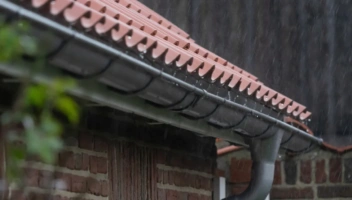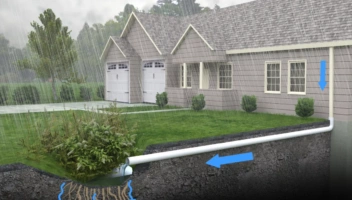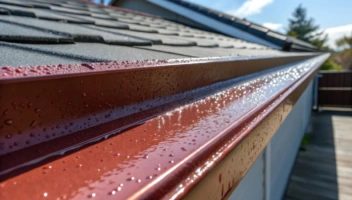If you need to replace your gutters, you’re probably wondering about gutter installation cost and what you should expect to pay for new gutters.
Based on the data at Leaf Filter, the average cost of installing new gutters in the US is approximately between $2,623.82 and $4,722.87.
The cost of installing gutters varies widely depending on a number of factors, such as:
- The location of your home
- The scope of the job
- The size and unique features of your home
- The current condition of your fascia and soffit
- The type of gutter system getting installed
Also, each gutter installer charges a different rate for labor. And depending on the manufacturer, the cost of materials will also vary.
So there are a number of different aspects that influence the cost of gutter installation. In this article, we’ll dive deeper into these factors and examine how and why they impact prices. We’ll also review data on the average cost of new gutters in different states.
In This Article:
- Home Size and Features
- Condition of Existing Hardware
- Type of Gutters
- Additional Costs to Consider
- Average Cost of New Gutters (by State)
- Frequently Asked Questions
- Final Thoughts
Home Size and Features

When getting quotes for new gutters, one of the biggest factors impacting cost is the size and layout of your home. Each home is different and has its own set of unique features that will determine how easy or how difficult it will be to install new gutters.
Home Size
Larger homes naturally require more linear footage of gutters and downspouts than smaller homes. The cost of new or replacement gutters is typically based on the linear footage required to more accurately account for materials and labor costs.
- A large two-story home with multiple roof sections and valleys may require gutters and downspouts around the entire perimeter of the house, wrapping around bump-outs, which could range from 150 to 300 or more linear feet.
- On a small single-level ranch home, in comparison, an uncomplicated rectangular shape may only require 100 to 150 linear feet of new gutters.
Roof Pitch and Angle
The pitch and angle of the roof will also affect gutter installation costs.
- Steeper-pitched roofs often use a gutter hanger system using spikes and ferrules to anchor the hangers into the fascia board.
- Shallow-pitched roofs may rely on screw-in hangers instead. Spike and ferrule systems typically cost more due to the materials and additional labor time.
Roof Complexity
In addition to more linear square footage of gutters, complex rooflines with lots of valleys and changes in pitch will also require more hangers and connections to secure the gutters.
Accessibility
The accessibility of the roof area also impacts the cost of new gutters.
- A multi-level house with high peaks will likely require the installers to put up scaffolding or use lifts to safely access all areas, impacting the gutter installation price.
- Single-story homes (like ranch-style houses) allow safer and easier access to gutter locations, so these installations won’t incur extra costs for lifts or scaffolding rentals.
Condition of Existing Hardware

Two crucial parts of your home that will impact the cost of gutter installation are the soffit and the fascia boards. A gutter installation contractor will need to assess the current state of your home’s soffits, fascia boards, and other overhang infrastructure when estimating the price for new gutters.
Rotted or damaged wood
If the fascia boards, soffit panels, or roof overhang structure are rotted or damaged, they’ll need to be repaired before installing new gutters. Replacing degraded materials helps provide a solid anchoring point for gutter hangers, which ensures the gutters won’t pull away from the home over time.
Level and alignment
If the existing fascia boards are not properly aligned or level, the gutter contractor may need to adjust the boards to create an even mounting surface for new gutters.
Holes and gaps
Patching any holes or gaps in the soffits and fascia ensures that your new gutter system will properly divert water away from your home, eliminating the risk of additional rot from moisture.
Roof Bracing
If the roof overhang structure is compromised and lacks proper bracing, it may need to be reinforced to support new gutters.
Should contractors need to make any of these repairs as part of the gutter installation, gutter replacement costs will be higher. Addressing issues with leveling, patching, replacing, or bracing takes time and materials cause installations to be more expensive.
If you see any underlying structural/wood flaws, be sure to point them out to the installation company as they’re building their quote. Sure, it will cost you more money, but neglecting these issues could lead to future gutter failure—and the significant damages and added expense that come with them—later on.
We don’t recommend DIY gutter installation unless you’re experienced in doing this type of work. If you want to DIY the installation of new gutters, here’s how to install gutters yourself, but when in doubt, it’s best to contact a professional.
Gutter Installation Cost by Type of Gutter

There are many different types of gutters available to homeowners. Gutter systems come in a wide variety of shapes, sizes, styles, and materials. And different options have different prices which vary by state and provider.
Depending on the material, shape, and size of your gutters, you can save money by opting for the less expensive types. However, choosing a less durable material could also end up costing you more in the long run.
Besides the sticker price of installation, it’s important to consider the long-term cost of gutters as well. The cheaper the type of gutter, the more expensive it may be in the long run to maintain. Cheap gutters can crack or buckle more easily than more expensive types.
By investing in a quality gutter system upfront, you get a gutter that should last much longer and require less repair. Be sure to compare the different types of rain gutters and evaluate your budget before making a final decision.
Additional Gutter Installation Costs to Consider
When estimating the cost of gutter installation, it’s important to consider the full scope of potential costs beyond the basic installation, so you can budget more effectively.
Here’s a breakdown of the most common additional costs to consider when replacing or installing new gutters.
Gutter Guards:
Gutter guards prevent leaves and debris from clogging the gutters, reducing maintenance needs and enhancing the system’s efficiency. Installation costs for gutter guards vary, depending on the type and quality chosen.
Gutter Flashing:

Flashing is important to help prevent water damage by directing water away from the roof line.
It’s also smart to discuss these options with the gutter installation professional to determine what’s necessary for your specific situation and how each choice can contribute to the longevity and effectiveness of your gutter system.
Average Cost of New Gutters (by State)

Gutter installation costs will vary widely across different states. The main factors that impact the cost of a new gutter system are labor expenses and the price of the materials, which will differ depending on the state and region you live in.
When pricing out new gutter installation, it’s important to get quotes from local contractors since they will know the going rates for labor and materials in your area.
To give an idea of the range of prices throughout the country, we’ve compiled average gutter installation costs from different states. Keep in mind that within each state, prices can vary depending on whether you live in an urban, suburban, or rural location. Metropolitan areas also tend to have higher labor costs.
Here are some average costs you may pay for professional gutter installation in the following states:
| State | 2025 Average Gutter Installation Cost (per linear foot) |
|---|---|
| Alabama | $18.14 to $23.64 |
| Arizona | $17.67 to $23.17 |
| Arkansas | $16.85 to $22.35 |
| California | $19.86 to $25.36 |
| Colorado | $16.91 to $22.41 |
| Connecticut | $16.32 to $21.82 |
| Delaware | $17.81 to $23.31 |
| Florida | $18.47 to $23.97 |
| Georgia | $19.85 to $25.35 |
| Idaho | $17.15 to $22.65 |
| Illinois | $18.69 to $24.19 |
| Indiana | $18.11 to $23.61 |
| Iowa | $17.31 to $22.81 |
| Kansas | $15.62 to $21.12 |
| Kentucky | $19.26 to $24.76 |
| Louisiana | $16.80 to $22.30 |
| Maine | $19.91 to $25.41 |
| Maryland | $21.29 to $26.79 |
| Massachusetts | $19.12 to $24.62 |
| Michigan | $17.50 to $23.00 |
| Minnesota | $17.42 to $22.92 |
| Mississippi | $17.26 to $22.76 |
| Missouri | $18.18 to $23.68 |
| Montana | $22.85 to $27.50 |
| Nebraska | $21.27 to $26.77 |
| Nevada | $16.66 to $22.16 |
| New Hampshire | $17.45 to $22.95 |
| New Jersey | $19.23 to $24.73 |
| New Mexico | $21.50 to $27.37 |
| New York | $18.68 to $24.18 |
| North Carolina | $18.63 to $24.13 |
| North Dakota | $15.78 to $21.28 |
| Ohio | $18.19 to $23.69 |
| Oklahoma | $17.54 to $23.04 |
| Oregon | $16.77 to $22.27 |
| Pennsylvania | $18.56 to $24.06 |
| Rhode Island | $17.59 to $23.09 |
| South Carolina | $18.37 to $23.87 |
| South Dakota | $15.35 to $19.70 |
| Tennessee | $20.36 to $25.86 |
| Texas | $16.37 to $21.87 |
| Utah | $17.05 to $22.55 |
| Vermont | $17.23 to $22.73 |
| Virginia | $19.76 to $25.26 |
| Washington | $18.66 to $24.16 |
| West Virginia | $20.85 to $26.35 |
| Wisconsin | $21.67 to $27.17 |
| Wyoming | $15.17 to $19.31 |
When reviewing these averages, use them as a general guideline for budgeting purposes, but be sure to get personalized quotes from contractors in your specific area before making a decision.
Overall, it’s crucial to get multiple bids and confirm what’s included in the price of new gutters to get an accurate understanding of the full costs in your particular situation. With proper planning and research, you’ll be able to find reputable companies that offer quality work at competitive prices in your area.
Frequently Asked Questions

Are gutters worth the investment?
Gutters are a valuable investment for most homes. Here’s why.
Gutters play a crucial role in directing rainwater away from your home’s foundation, walls, and landscaping, thus preventing soil erosion, basement flooding, and damage to siding. Without gutters, water runoff can also lead to staining on brick and siding. It can even damage the paint on your home’s exterior.
Additionally, gutters help reduce mold and mildew growth, which can be detrimental to a house’s structure and the health of its inhabitants.
All in all, the cost of installing gutters is relatively low compared to the extensive damage that water can cause to a home without proper drainage.
Are seamless gutters worth it?
Seamless gutters are often considered worth the investment. Unlike traditional sectional gutters, seamless gutters are made from a single piece of material and are custom-fitted to your home. This design minimizes leaks, as there are no joints except at the corners and downspouts.
Seamless gutters are also more aesthetically pleasing due to their smooth, uniform look. They require less maintenance than sectional gutters, as the lack of seams reduces the chances of debris accumulation.
They can be more expensive upfront but may save you money in the long run due to lower repair and maintenance costs.
Do new gutters increase your home’s value?
While new gutters alone may not significantly increase your home’s market value, they can enhance its curb appeal and functionality, making it more attractive to potential buyers. Efficient gutters prevent water damage that can be caused by clogged gutters, a major concern for homeowners and homebuyers.
By demonstrating that your home is well-maintained and protected against water-related issues, new gutters can contribute positively to the overall perceived value of your home.
This is especially true if your gutters are part of a comprehensive system that includes water management features like gutter guards or efficient downspouts.
How many years do gutters last?
The lifespan of gutters depends on the material and the level of maintenance. Galvanized steel gutters typically last about 20 years, while copper gutters can last 50 years or more. However, factors such as weather conditions, tree coverage, and regular maintenance play a significant role in their longevity.
Regular cleaning and inspection can prevent issues like gutter clogging, rust, and wear from adversely affecting their condition and lifespan. Gutters may have a shorter life expectancy in areas with extreme weather, such as heavy snow or high winds.
How often should you clean new gutters?
Cleaning out your gutters regularly is an essential step to prevent clogs inside your gutters and the subsequent problems that clogged gutters can cause.
The general rule is to clean out your gutters at least twice per year, in the spring and the fall. However, you may need to clean them out more often if you live in an area with frequent storms, strong winds, hail, or heavy snow and ice. You’ll also need to clean out your gutters more frequently if your home is surrounded by trees that shed pine needles, leaves, and other debris.
Final Thoughts on Gutter Installation Cost
When was the last time you were excited to clean out your gutters? We’re betting you answered “never.”
The good news is that you can eliminate the chore of cleaning out your gutters and for all by installing our gutter protection on your new gutters. Our LeafFilter® professionals take care of every step of the process. We’ll perform the final gutter cleaning of your old gutters to avoid making a mess upon removal. Best of all, we’ll install new seamless gutters, and protect your whole system with our patented micro mesh gutter protection.
So, what are you waiting for? Request your free, no-obligation estimate today!
Frequently Asked Questions (FAQs)
Are gutters worth the investment?
Gutters play a crucial role in directing rainwater away from your home’s foundation, walls, and landscaping, thus preventing soil erosion, basement flooding, and damage to siding. Without gutters, water runoff can also lead to staining on brick and siding. It can even damage the paint on your home’s exterior.
Additionally, gutters help reduce mold and mildew growth, which can be detrimental to a house’s structure and the health of its inhabitants. Overall, the cost of installing gutters is relatively low compared to the extensive damage that water can cause to a home without proper drainage.
Are seamless gutters worth it?
Seamless gutters are often considered worth the investment. Unlike traditional sectional gutters, seamless gutters are made from a single piece of material, usually aluminum, and are custom-fitted to your home. This design minimizes leaks, as there are no joints except at the corners and downspouts.
Although more costly upfront, seamless gutters are also more aesthetically pleasing due to their smooth, uniform look. They require less maintenance than sectional gutters, as the lack of seams reduces the chances of debris accumulation.
Do new gutters increase your home’s value?
While new gutters alone may not significantly increase your home’s market value, they can enhance its curb appeal and functionality, making it more attractive to potential buyers. Efficient gutters prevent water damage that can be caused by clogged gutters, a major concern for homeowners and homebuyers.
How many years do gutters last?
The lifespan of gutters depends on the material and the level of maintenance. Aluminum and galvanized steel gutters typically last about 20 years, while copper gutters can last 50 years or more. However, factors such as weather conditions, tree coverage, and regular maintenance play a significant role in their longevity.
Regular cleaning and inspection can prevent issues like gutter clogging, rust, and wear from adversely affecting their condition and lifespan. Gutters may also have a shorter life expectancy in areas with extreme weather, such as heavy snow or high winds.
How often should you clean out new gutters?
Cleaning out your gutters regularly is an essential step to prevent clogs inside your gutters and the subsequent problems that clogged gutters can cause.
The general rule is to clean out your gutters at least twice per year, in the spring and the fall. However, you may need to clean them out more often if you live in an area with frequent storms, strong winds, hail, or heavy snow and ice or if your home is surrounded by trees that shed pine needles, leaves, and other debris.


